tire type TOYOTA TACOMA 2018 Owners Manual (in English)
[x] Cancel search | Manufacturer: TOYOTA, Model Year: 2018, Model line: TACOMA, Model: TOYOTA TACOMA 2018Pages: 696, PDF Size: 11.72 MB
Page 6 of 696
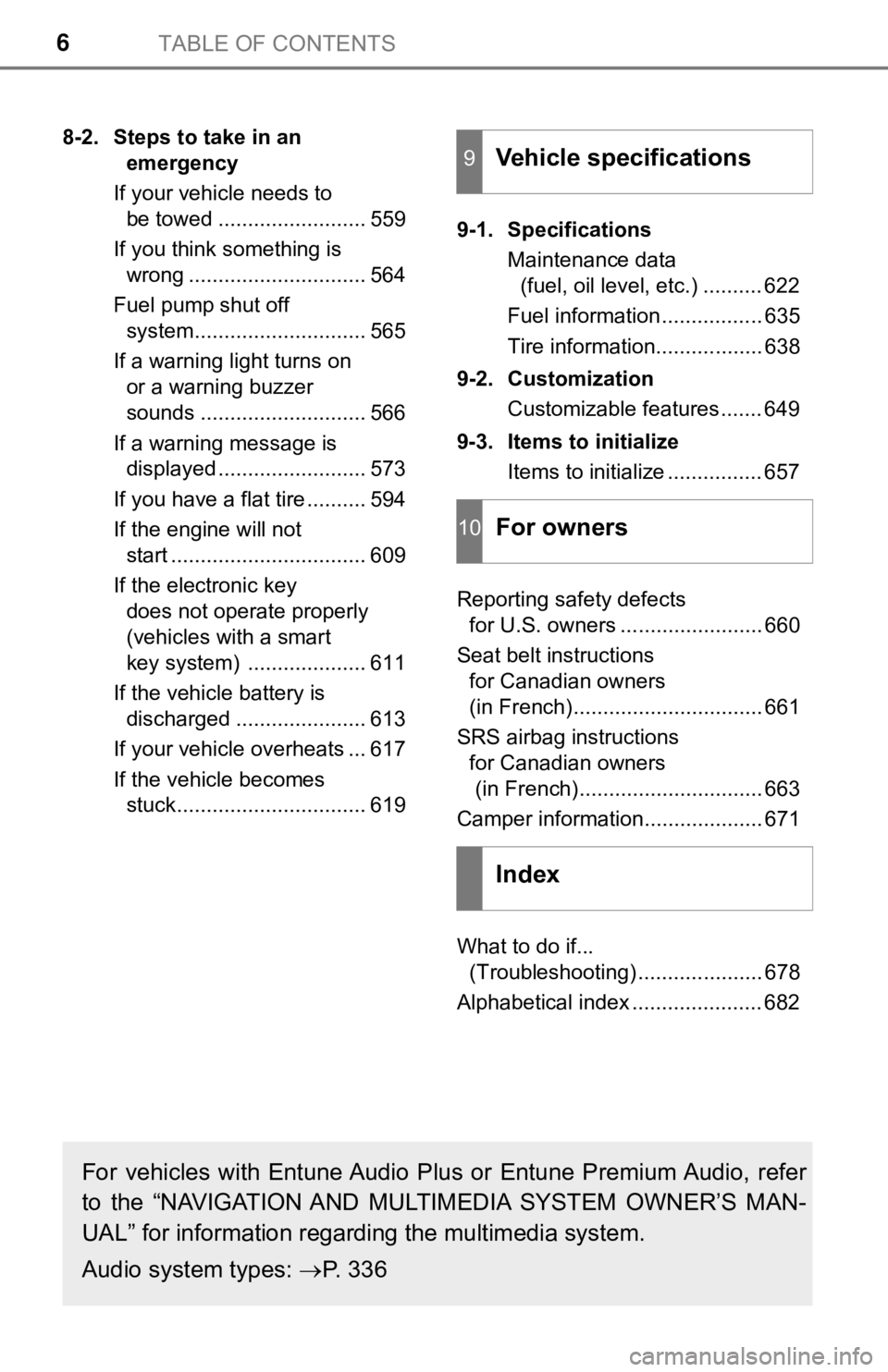
TABLE OF CONTENTS6
8-2. Steps to take in an emergency
If your vehicle needs to be towed ......................... 559
If you think something is wrong .............................. 564
Fuel pump shut off system............................. 565
If a warning light turns on or a warning buzzer
sounds ............................ 566
If a warning message is displayed ......................... 573
If you have a flat tire .......... 594
If the engine will not start ................................. 609
If the electronic key does not operate properly
(vehicles with a smart
key system) .................... 611
If the vehicle battery is discharged ...................... 613
If your vehicle overheats ... 617
If the vehicle becomes stuck................................ 619 9-1. Specifications
Maintenance data (fuel, oil level, etc.) .......... 622
Fuel information ................. 635
Tire information.................. 638
9-2. Customization Customizable features ....... 649
9-3. Items to initialize Items to initialize ................ 657
Reporting safety defects for U.S. owners ........................ 660
Seat belt instructions for Canadian owners
(in French)................................ 661
SRS airbag instructions for Canadian owners
(in French)............................... 663
Camper information.................... 671
What to do if... (Troubleshooting) ..................... 678
Alphabetical index ...................... 6829Vehicle specifications
10For owners
Index
For vehicles with Entune Audio Pl us or Entune Premium Audio, refer
to the “NAVIGATION AND MULTIMEDIA SYSTEM OWNER’S MAN-
UAL” for information regarding the multimedia system.
Audio system types: P. 336
Page 15 of 696

15Pictorial index
Fuel filler door . . . . . . . . . . . . . . . . . . . . . . . . . . . . . . . . . . . . P. 224
Refueling method . . . . . . . . . . . . . . . . . . . . . . . . . . . . . . . . . . . P. 224
Fuel type/fuel tank capacity . . . . . . . . . . . . . . . . . . . . . . . . . . . P. 626
Tires . . . . . . . . . . . . . . . . . . . . . . . . . . . . . . . . . . . . . . . . . . . . P. 519
Tire size/inflation pressure . . . . . . . . . . . . . . . . . . . . . . . . . . . . P. 633
Winter tires/tire chain . . . . . . . . . . . . . . . . . . . . . . . . . . . . . . . . P. 325
Checking/rotation/tire pressure warning system
*2 . . . . . . . . . P. 519
Coping with flat tires . . . . . . . . . . . . . . . . . . . . . . . . . . . . . . . . P. 594
Hood . . . . . . . . . . . . . . . . . . . . . . . . . . . . . . . . . . . . . . . . . . . . P. 505
Opening . . . . . . . . . . . . . . . . . . . . . . . . . . . . . . . . . . . . . . . . . . P. 505
Engine oil . . . . . . . . . . . . . . . . . . . . . . . . . . . . . . . . . . . . . . . . . P. 627
Coping with overheat . . . . . . . . . . . . . . . . . . . . . . . . . . . . . . . . P. 617
Camera . . . . . . . . . . . . . . . . . . . . . . . . . . . . . . . . . . . . . . . . . . P. 281
Headlights . . . . . . . . . . . . . . . . . . . . . . . . . . . . . . . . . . . . . . . P. 211
Fog lights
*2 . . . . . . . . . . . . . . . . . . . . . . . . . . . . . . . . . . . . . . P. 220
Front turn signal lights . . . . . . . . . . . . . . . . . . . . . . . . . . . . . P. 209
Parking lights (bulb type)
*2/
daytime running lig hts (bulb type)
*2. . . . . . . . . . . . . . . . . . P. 211
Parking lights (LED type)
*2/
daytime running lights (LED type)
*2 . . . . . . . . . . . . . . . . . . P. 211
Rear turn signal/tail lights . . . . . . . . . . . . . . . . . . . . . . . . . . . P. 209
Stop/tail lights . . . . . . . . . . . . . . . . . . . . . . . . . . . . . . . . . . . . P. 211
Hill-start assist control
*2 . . . . . . . . . . . . . . . . . . . . . . . . . . . . . P. 3 20
License plate lights . . . . . . . . . . . . . . . . . . . . . . . . . . . . . . . . P. 211
Back-up lights
Shifting the shift lever to R . . . . . . . . . . . . . . . . . . . . . . . . P. 201, 207
Side marker lights . . . . . . . . . . . . . . . . . . . . . . . . . . . . . . . . . P. 211
6
7
8
9
Light bulbs of the exter ior lights for driving
(Replacing method: P. 543, Watts: P. 634)
*1: Vehicles with a smart key system
*2: If equipped
10
11
12
13
14
15
16
17
18
Page 326 of 696

3264-6. Driving tips
●Park the vehicle and move the shift lever to P (automatic trans mis-
sion) or 1 or R (manual transmiss ion) without setting the parking
brake. The parking brake may freeze up, preventing it from bein g
released. If the vehicle is park ed without setting the parking brake,
make sure to block the wheels.
Failure to do so may be dangerou s because it may cause the vehi-
cle to move unexpectedly, pos sibly leading to an accident.
● On vehicles with an automatic transmission, if the vehicle is p arked
without setting the parking brake, confirm that the shift lever cannot
be moved out of P.
The shift lever will be locked if it is attempted to be shifted from P to
any other position without depressing the brake pedal. If the s hift
lever can be shifted from P, there may be a problem with the sh ift
lock system. Have the vehicle in spected by your Toyota dealer
immediately.
Use the correct tire chain size when mount ing the tire chains.
Chain size is regulate d for each tire size.
Side chain
(0.2 in. [5 mm] in diameter)
Cross chain
(0.25 in. [6.3 mm] in diameter)
Regulations regarding the use of tire chains vary depending on loca-
tion and type of road. Always chec k local regulations before installing
chains.
When parking the vehicle
Selecting tire chains
1
2
Regulations on the use of tire chains
Page 327 of 696
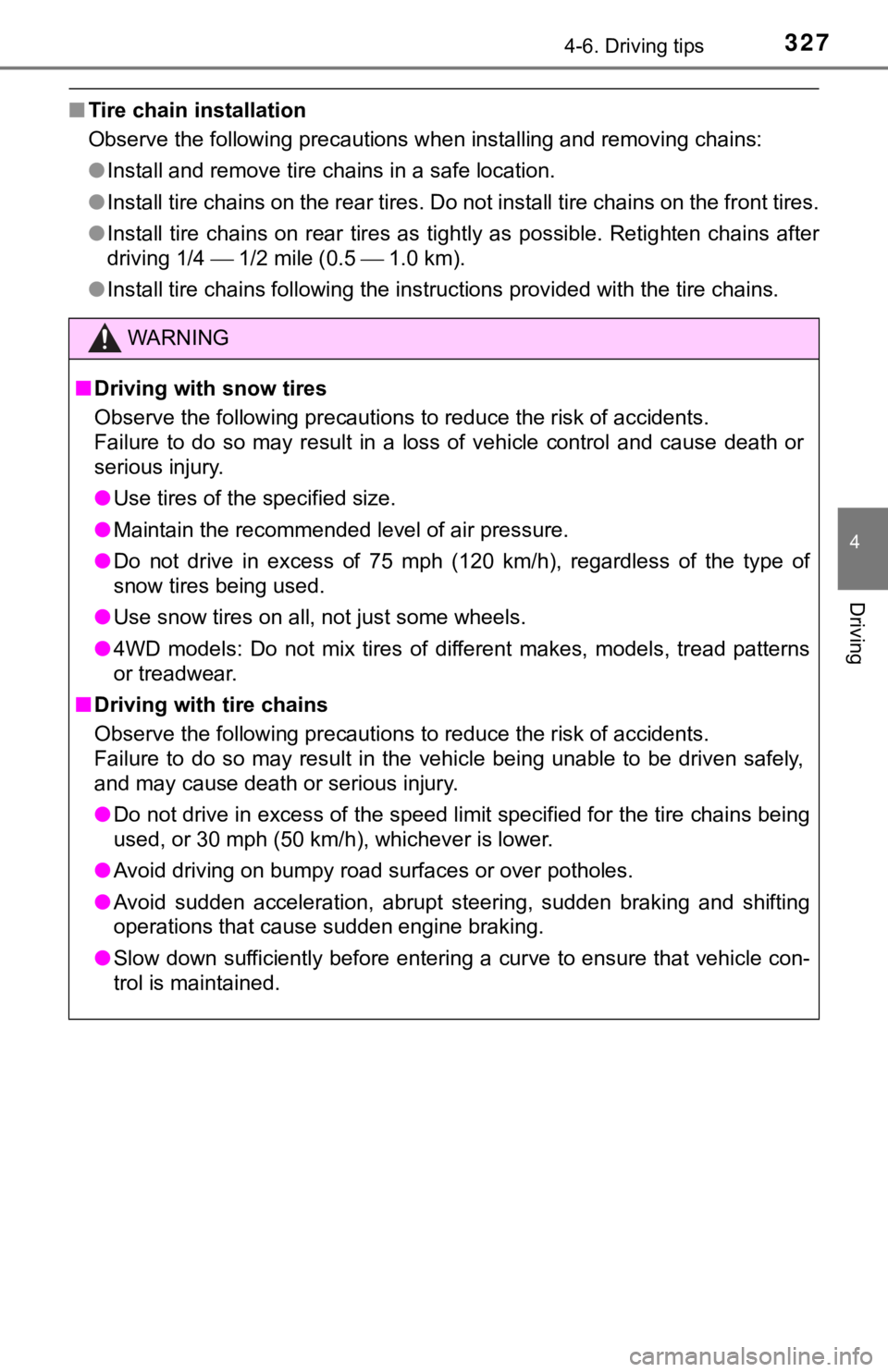
3274-6. Driving tips
4
Driving
■Tire chain installation
Observe the following precautions when installing and removing chains:
● Install and remove tire chains in a safe location.
● Install tire chains on the rear tires. Do not install tire chains on the front tires.
● Install tire chains on rear tires as tightly as possible. Retig hten chains after
driving 1/4 1/2 mile (0.5 1.0 km).
● Install tire chains following the instructions provided with th e tire chains.
WARNING
■Driving with snow tires
Observe the following precautions to reduce the risk of acciden ts.
Failure to do so may result in a loss of vehicle control and ca use death or
serious injury.
● Use tires of the specified size.
● Maintain the recommended level of air pressure.
● Do not drive in excess of 75 mph (120 km/h), regardless of the type of
snow tires being used.
● Use snow tires on all, not just some wheels.
● 4WD models: Do not mix tires of different makes, models, tread patterns
or treadwear.
■ Driving with tire chains
Observe the following precautions to reduce the risk of acciden ts.
Failure to do so may result in the vehicle being unable to be d riven safely,
and may cause death or serious injury.
● Do not drive in excess of the speed limit specified for the tir e chains being
used, or 30 mph (50 km/h), whichever is lower.
● Avoid driving on bumpy road surfaces or over potholes.
● Avoid sudden acceleration, abrupt steering, sudden braking and shifting
operations that cause sudden engine braking.
● Slow down sufficiently before entering a curve to ensure that v ehicle con-
trol is maintained.
Page 523 of 696
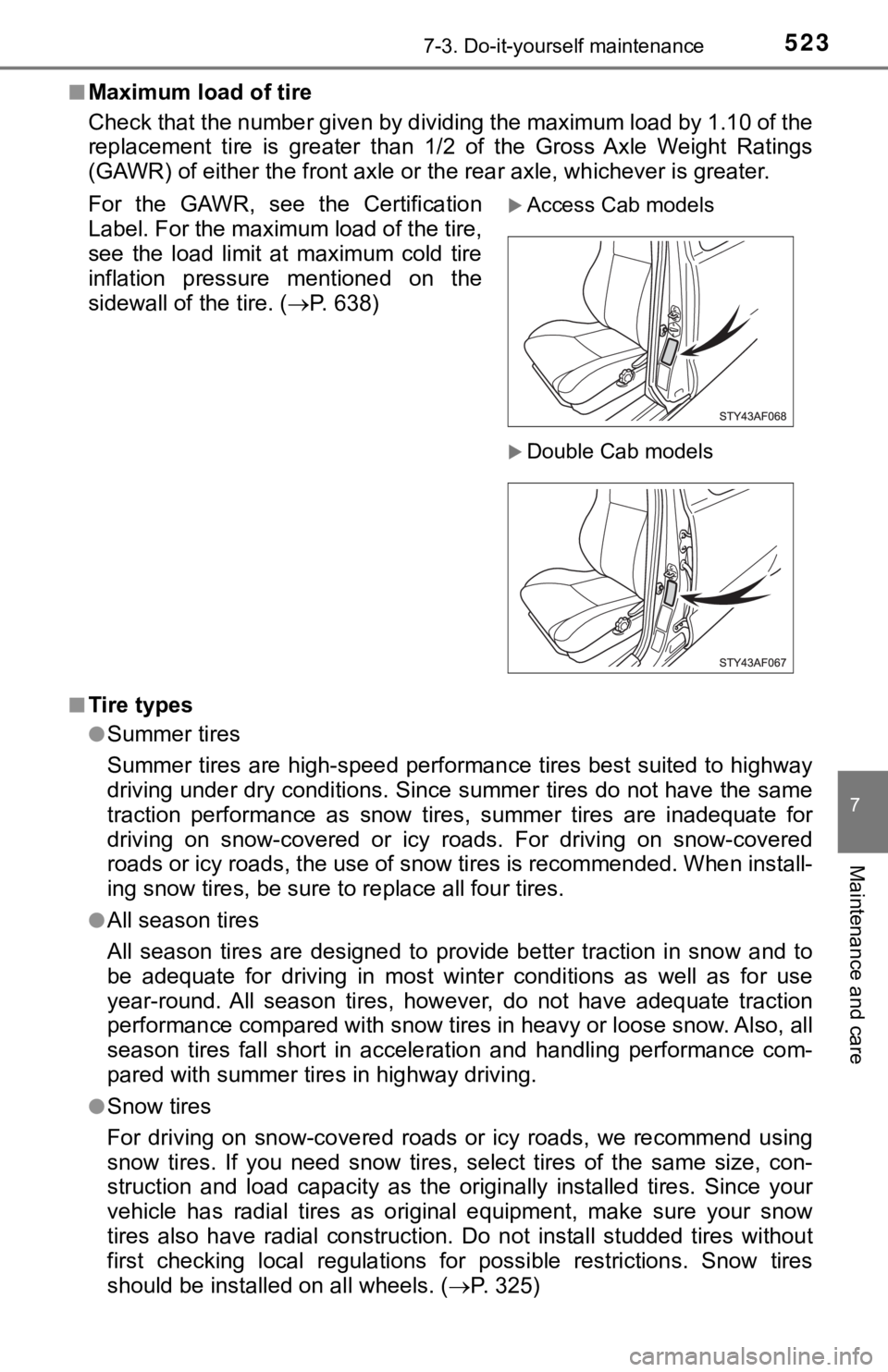
5237-3. Do-it-yourself maintenance
7
Maintenance and care
■Maximum load of tire
Check that the number given by dividing the maximum load by 1.10 of the
replacement tire is greater than 1/2 of the Gross Axle Weight R atings
(GAWR) of either the front axle or the rear axle, whichever is greater.
■Tire types
●Summer tires
Summer tires are high-speed performance tires best suited to hi ghway
driving under dry conditions. Si nce summer tires do not have th e same
traction performance as snow tires, summer tires are inadequate for
driving on snow-covered or icy ro ads. For driving on snow-covered
roads or icy roads, the use of snow tires is recommended. When install-
ing snow tires, be sure to replace all four tires.
●All season tires
All season tires are designed to provide better traction in sno w and to
be adequate for driving in most winter conditions as well as fo r use
year-round. All season tires, however, do not have adequate tra ction
performance compared with snow tires in heavy or loose snow. Al so, all
season tires fall short in acceleration and handling performanc e com-
pared with summer tires in highway driving.
●Snow tires
For driving on snow-covered roads or icy roads, we recommend us ing
snow tires. If you need snow tires, select tires of the same si ze, con-
struction and load capacity as t he originally installed tires. Since your
vehicle has radial tires as original equipment, make sure your snow
tires also have radial construct ion. Do not install studded tires without
first checking local regulations for possible restrictions. Sno w tires
should be install ed on all wheels. ( P. 325)
For the GAWR, see the Certification
Label. For the maximum load of the tire,
see the load limit at maximum cold tire
inflation pressure mentioned on the
sidewall of the tire. (
P. 6 3 8 )
Access Cab models
Double Cab models
Page 531 of 696
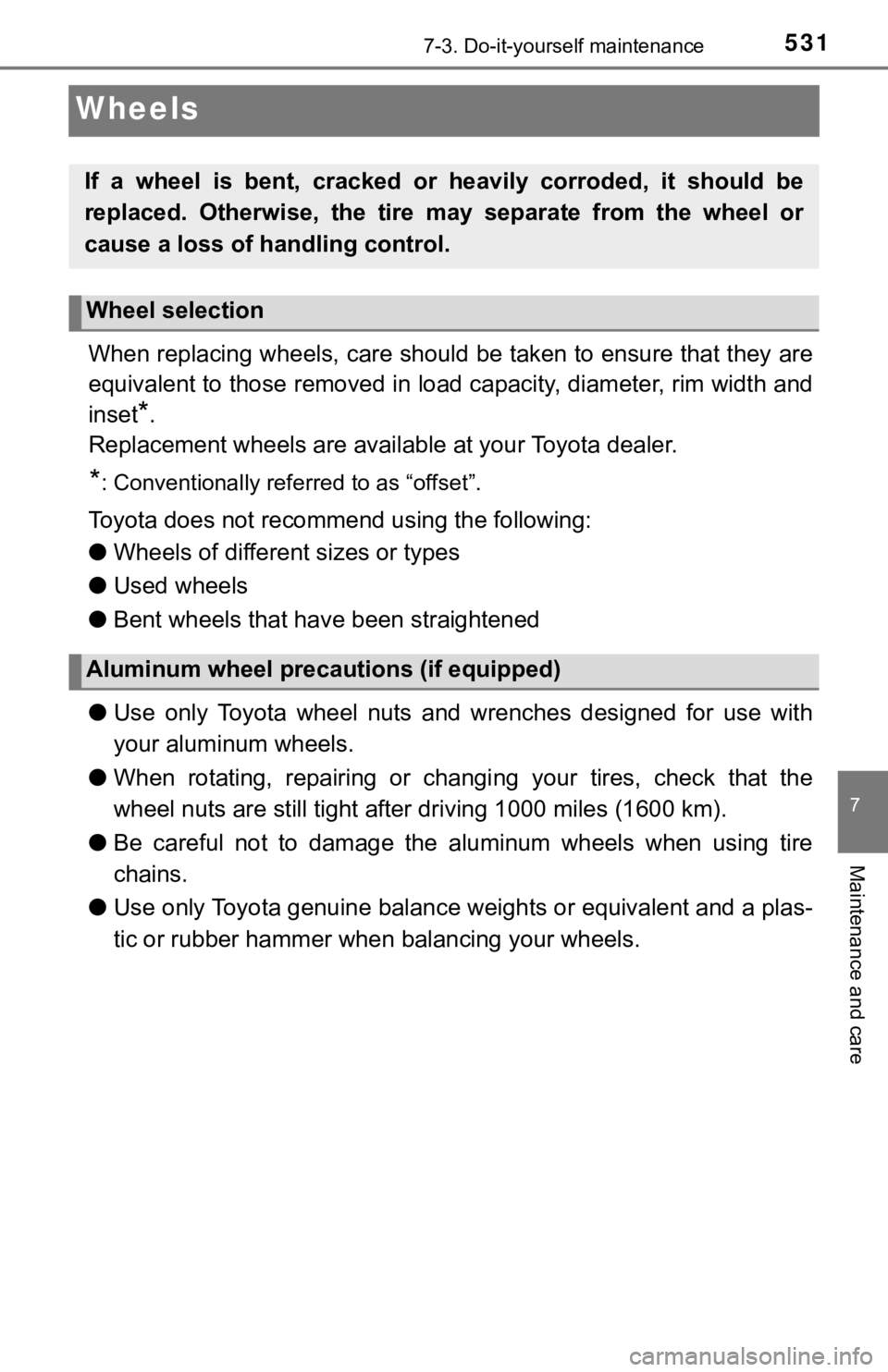
5317-3. Do-it-yourself maintenance
7
Maintenance and care
Wheels
When replacing wheels, care should be taken to ensure that they are
equivalent to those removed in load capacity, diameter, rim wid th and
inset
*.
Replacement wheels are available at your Toyota dealer.
*: Conventionally referred to as “offset”.
Toyota does not recommend using the following:
● Wheels of different sizes or types
● Used wheels
● Bent wheels that hav e been straightened
● Use only Toyota wheel nuts and wrenches designed for use with
your aluminum wheels.
● When rotating, repairing or changi ng your tires, check that the
wheel nuts are still tight afte r driving 1000 miles (1600 km).
● Be careful not to damage the aluminum wheels when using tire
chains.
● Use only Toyota genuine balance we ights or equivalent and a plas-
tic or rubber hammer when balancing your wheels.
If a wheel is bent, cracked or heavily corroded, it should be
replaced. Otherwise, the tire may separate from the wheel or
cause a loss of handling control.
Wheel selection
Aluminum wheel pre cautions (if equipped)
Page 622 of 696

6229-1. Specifications
Maintenance data (fuel, oil level, etc.)
*1: Unladen vehicle
*2: P265/60R18 tires
*3: Vehicles with a over fender
■
TWR (Trailer Weight Rating)
P. 1 7 9
Dimensions
Cab type Access Cab
Overall length212.3 in. (5392.3 mm)
Overall width 74.4 in. (1890.5 mm)
Overall height*170.6 in. (1792.2 mm)
Wheelbase127.8 in. (3247 mm)
Front tread63.0 in. (1599 mm)
63.3 in. (1609 mm)*2
Rear tread63.2 in. (1606 mm)
63.6 in. (1616 mm)*2
Cab typeDouble Cab
With short deck With long deck
Overall length
212.3 in. (5392.3 mm) 225.5 in. (5727.3 mm)
Overall width74.4 in. (1890.5 mm)
75.2 in. (1910.3 mm)*3
Overall height*170.6 in. (1792.2 mm)
Wheelbase
127.8 in. (3247 mm) 141.0 in. (3582 mm)
Front tread63.0 in. (1599 mm)
63.3 in. (1609 mm)*2
Rear tread63.2 in. (1606 mm)
63.6 in. (1616 mm)*2
Page 638 of 696

6389-1. Specifications
Tire information
Tire size ( P. 640)
DOT and Tire Identification Number (TIN) ( P. 639)
Location of treadwear indicators ( P. 519)
Tire ply composition and materials
Plies are layers of rubber-coated parallel cords. Cords are the strands
which form the p lies in a tire.
Uniform tire quality grading
For details, see “Uniform Tire Q uality Grading” that follows.
Load limit at maximum cold tire inflation pressure ( P. 644)
Maximum cold tire inflation pressure ( P. 644)
This means the press ure to which a tire may be inflated.
TUBELESS or TUBE TYPE
A tubeless tire does not have a tube and air is directly put into the tire.
A tube type tire has a tube insi de the tire and the tube mainta ins the air
pressure.
Radial tires or bias-ply tires
A radial tire has “RADIAL” on the sidewall. A tire not marked “ RADIAL”
is a bias-ply tire.
Summer tire or all season tire ( P. 523)
An all season tire has “M+S” on the sidewall. A tire not marked “M+S”
is a summer tire.
Typical tire symbols
1
2
3
4
5
6
7
8
9
10
Page 639 of 696

6399-1. Specifications
9
Vehicle specifications
DOT symbol*
Tire Identification Number (TIN)
Tire manufacturer’s identification mark
Tire size code
Manufacturer’s optional tire type code (3 or 4 letters)
Manufacturing week
Manufacturing year
Manufacturer’s code
*:The DOT symbol certifies that the tire conforms to applicable Federal
Motor Vehicle Safety Standards.
Typical DOT and Tire Iden tification Number (TIN)
Ty p e AType B
1
2
3
4
5
6
7
8
Page 645 of 696
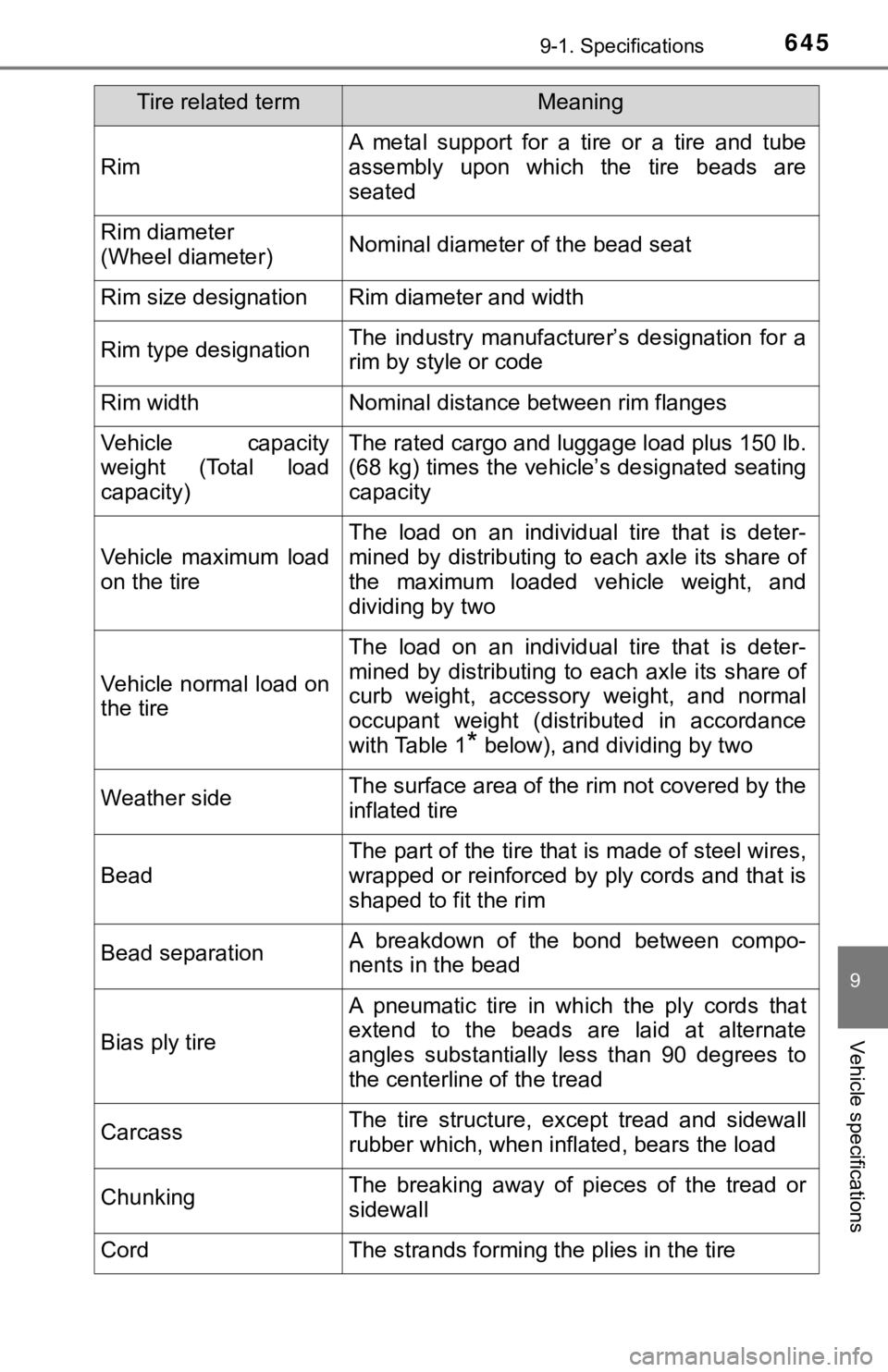
6459-1. Specifications
9
Vehicle specifications
Rim
A metal support for a tire or a tire and tube
assembly upon which the tire beads are
seated
Rim diameter
(Wheel diameter)Nominal diameter of the bead seat
Rim size designationRim diameter and width
Rim type designationThe industry manufacturer’s designation for a
rim by style or code
Rim widthNominal distance between rim flanges
Vehicle capacity
weight (Total load
capacity)The rated cargo and l uggage load plus 150 lb.
(68 kg) times the vehicle’s designated seating
capacity
Vehicle maximum load
on the tire
The load on an individual tire that is deter-
mined by distributing to each axle its share of
the maximum loaded vehicle weight, and
dividing by two
Vehicle normal load on
the tire
The load on an individual tire that is deter-
mined by distributing to each axle its share of
curb weight, accessory weight, and normal
occupant weight (distributed in accordance
with Table 1
* below), and dividing by two
Weather sideThe surface area of the rim not covered by the
inflated tire
Bead
The part of the tire that is made of steel wires,
wrapped or reinforced by ply cords and that is
shaped to fit the rim
Bead separationA breakdown of the bond between compo-
nents in the bead
Bias ply tire
A pneumatic tire in which the ply cords that
extend to the beads are laid at alternate
angles substantially less than 90 degrees to
the centerline of the tread
CarcassThe tire structure, except tread and sidewall
rubber which, when inflated, bears the load
ChunkingThe breaking away of pieces of the tread or
sidewall
CordThe strands forming th e plies in the tire
Tire related termMeaning